
|
 |
||||||
|---|---|---|---|---|---|---|---|
| Bell P-39 Airacobra |
 |
 |
 |
 |
 |
||
 |
 |
 |
 |
 |
|||
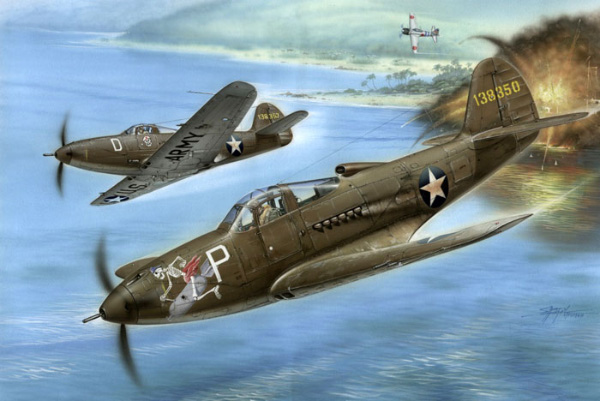 |
||||
|
The 1930s was a time of transition and Art Deco was all the rage. Deco emerged from the Interwar period when rapid industrialization was transforming culture and it’s no doubt the eclectic style of the times influenced the design of the Bell XP-39 Airacobra. This was a time when some commercial aircraft were faster than USAAC fighters and compared to the Boeing P-26, Northrop A-17 or Seversky P-35, the P-39's streamlined finish made it look like a winner. It was a sleek modern airplane, unlike anything ever seen before. It featured some pretty novel ideas for a fighter plane and the design marked a singular departure from all other conventional designs—it made quite an impression.
On March 19, 1937 the United States Army Air Corps (USAAC) issued specification X-609 for a new fighter and Bell aircraft created two designs, the Model 3 and Model 4. Both designs were presented to the USAAC and Model 4 was retained for further development. On October 7, 1937,1 the USAAC ordered a single XP-39 prototype and although it was only one aircraft, it looked promising and the XP-39 made its first flight on April 6, 1938.2 The main features included: | ||||
| • | An Allison V-12 engine that was fully enclosed behind the cockpit. | • | Automobile-type doors with roll down windows on either side of the cockpit. | • | A tricycle landing gear that was very new at the time and would become a Bell trademark. | • | An M4 37-millimeter cannon that fired through the propeller hub. |
|
Like the Bf 109, the P-39 had a cannon in the nose, but that’s where the similarities ended and the P-39s promised performance never materialized. The original turbo-supercharged XP-39 reached a speed of 390 mph at 20,000 feet (Bell claimed 400 mph),3 but once the National Advisory Committee for Aeronautics (NACA) implemented its own design changes, performance fell off sharply. After the meddling began, weight was added and some desirable features were removed and the production P-39 became incapable of fulfilling the combat role that it was envisioned for. The biggest mistake was to eliminate the turbo-supercharger. Without the turbo, speed fell off sharply and was reduced to 368 mph at 13,600 ft.4 The turbo-supercharger made the P-38 and P-47 great high-altitude fighters, but the P-39 struggled to achieve 25,000 ft. and at 30,000 feet it was pretty well spent. It could not operate with any efficiency above 15,000 ft. thus limiting it to low-altitude work.
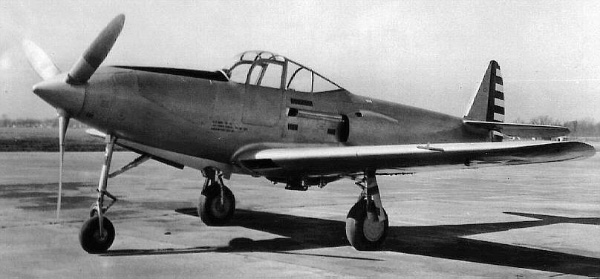
The P-39 Airacobra featured a tricycle landing gear which was the first such arrangement ever used on a production fighter. Also different were an engine behind the cockpit, automobile-type doors and a cannon that fired through the propeller hub. Above is the XP-39 showing the original canopy and side air inlets. The oil cooler air intake was on the right-hand side while the supercharger air intake was on the left. | ||||
|
A major difference compared to contemporary fighters at the time was to place the engine behind the cockpit. The engine drove a ten foot driveshaft that attached to the propeller gearbox at the nose of the aircraft. The reasoning for such a radical design feature was to place the engine aft of the center-of-gravity to increase maneuverability. Flying tactics were still based on World War I flying strategies, but tactics would change dramatically in the years to come. This was evident in the P-38 and F6F Hellcat which were very successful airplanes despite the fact that they could not out turn a Zero. With the engine behind the center-of-gravity, this gave the P-39 a tendency to stall in a tight turn and possibly go into a flat spin, which many a pilot did not recover from.5
Another flaw of the P-39 was its short range, but this was not the fault of Bell engineers. The thinking at the time was that single-engine fighters would be short-range interceptors that would take off at a moment’s notice and then return to a base nearby. This was certainly the case in designing the Spitfire, Bf 109, Hawker Hurricane, and the Grumman F4F. The only planners with the foresight for long-range missions were the designers of the Mitsubishi A6M Zero. Before the war had started, Japanese planners foresaw the need for long-range operations over the Pacific. It wasn’t until the Allies were well into the war before they realized the need for long-range fighter escorts to protect their bombers on extended raids over Germany. |
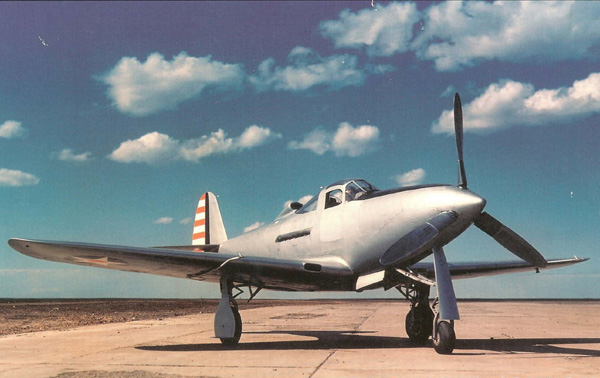 |
|---|
|
The NACA recommended changes to lower the profile of the cockpit canopy and to remove the side inlets and replace them with the characteristic scoop aft of the canopy. The XP-39B above without armament was constructed from the redesigned XP-39.
|
|
The original designation was P-45 but this reverted back to P-39 before the first of eighty production models were ordered by the USAAC on August 10,1939. Before this first order was delivered, the French had also ordered 200 airplanes, but after France was defeated in 1940, the order was taken over by the British Purchasing Commission that became part of a total British order of 675 aircraft, but most of these aircraft would never be delivered to England. At that time, the Royal Air Force (RAF) needed planes for aerial dog fighting, and while they found the Airacobra fine for low-level operations, this wasn't the type of aerial combat they had in mind for the P-39.
The first P-39s sent to England in July 1941 went to the No. 601 "County of London" squadron who were hoping to dump their old Hurricanes for a new and more modern fighter. The British replaced the original 37 mm cannon with a Hispano-Suiza 20 mm and the 0.30 caliber machine guns were replaced with Browning .303s . They were greatly disappointed to find the P-39's top speed was 30 mph less than expected. Bell had also claimed that the P-39 could operate above 36,000 ft.6 In the real world however, above 15,000 ft., Spitfires, Hurricanes, Bf 109s and the new Hawker Typhoon flew circles around the P-39. Undoubtedly, the British felt that the yanks had taken them to the cleaners and so, they refused the rest of the order. The 601 was the only British squadron to be equipped with the type and they flew only four missions with P-39s.7 Without blinking an eye, the 601 converted to Spitfires in March 1942 and the British P-39s diverted back to the USAAC were designated as P-400s. Two hundred P-400s were sent to the Fifth Air Force in Australia for service in the Pacific. |
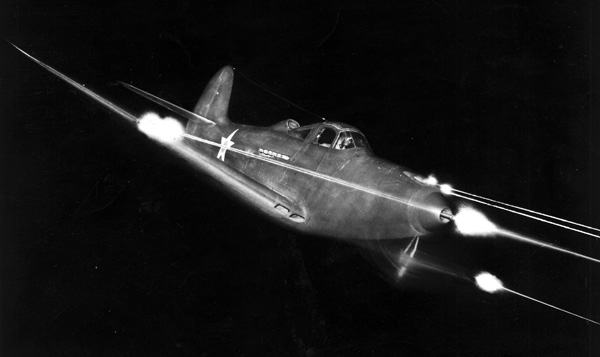 |
|---|
|
A P-39 firing all guns simultaneously. This version shows the 37 mm cannon in the spinner hub, two nose mounted 0.50 caliber machine guns and four wing mounted 0.30 caliber machine guns. Note the cooling radiators mounted at the wing root leading edge.
|
|
From the British order, 212 P-39s were sent to Russia and this was the beginning of the 4,746 P-39s which were to equip Russian squadrons. This was almost half of the total production of all P-39s. They were highly regarded by the Russians for their ground-attack capability and performed well in ground-strafing operations. The Russians produced 28 aces with at least 15 victories flying P-39 Airacobras. Aleksandr Pokryshkin scored approximately 48 victories and Grigori Rechkalov scored 44 victories in P-39s. Pokryshkin was able to make a big improvement in the P-39’s firing control system. He said it was impossible to keep the cannon gun sight aimed on the target, because the cannon trigger was on top of the control stick. He had his regiments P-39s rigged so that the cannons and machine guns would fire simultaneously. A salvo from a P-39 rigged in this configuration would disintegrate the target.8
The 45th regiment of the Russian 216 Fighter Division (9th Guards) were the first to receive P-39s. They had already been flying P-40s so the transition was not so difficult, since the engine, instruments and cockpit flight controls were similar. The 16th regiment was the next to receive the P-39 on April 9, 1943. The basic units of the 9th Guard were the 16th, 100th, 104th and the 45th joined afterwards. The 16th and 45th became the combat core of the 9th Guard.9 What made the P-39 and P-63 so successful in Russia was that on the Eastern front, most aerial battles were flown at lower altitudes at around 15,000 ft. or less. In Europe the situation was quiet different. The majority of US fighters were assigned to escort high-altitude B-17s and B-24s on long distance bombing raids over Germany. US Fighters often flew top cover for bomber squadrons at 30,000 ft. or higher, so most dogfights began at high altitude. Whereas in Russia, the distances travelled were much shorter and the Russian Air Force wasn’t making the same type of long-distance, high-altitude bombing runs that the Americans and British were doing. E.g. The top scoring fighter of all time, Erich Hartmann scored most of his 352 victories in Russia. Luftwaffe pilots fought almost every day while flying defensive, short flights, on their own territory where four and even five missions per day on the Eastern Front were commonplace. Also, the Russian Yak-3 and La-5FN were very successful fighters that performed best at altitudes below 4,000 m.10 |
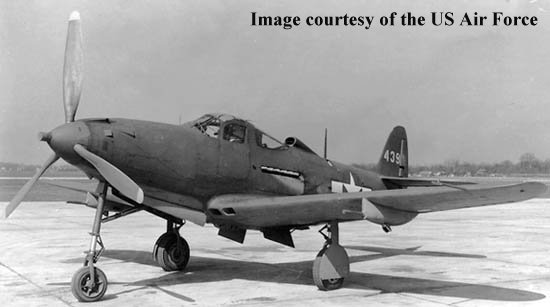 |
|---|
|
A P-39Q with two 0.50 caliber machine guns mounted in under-wing pods.
|
|
As the first 80 production models of the P-39C started arriving at USAAC squadrons in January 1941, the first 20 were configured with two 0.50 caliber and two additional 0.30 caliber machine guns in the nose. The remaining 60 were provisioned with two extra 0.30 caliber machine guns, self-sealing tanks, and a provision for a 500 lb. pound bomb or 75 gallon drop tank carried beneath the fuselage. All four 0.30 caliber machine guns were placed in the wings and this was designated as the P-39D. 923 P-39Ds were built in three different configurations.
The outward appearance of the P-39 changed very little and some of the main changes during production were as follows: |
| • | The side air inlets were removed from the prototype and moved to the characteristic scoop behind the canopy. | • | The early P-39s used a three bladed Curtiss Electric propeller and the P-39F, P-39J and P-39K used an Aeroproducts four blade hydraulically controlled propeller. The P-39L reverted back to the three blade prop and the P-39Q-21 and P-39Q-25 used the four blade prop. | • | The P-39N carried less armor and fuel to improve performance. | • | The P-39Q replaced the four wing mounted 0.30 caliber machine guns with two 0.50 caliber machine guns mounted in under-wing pods. |
| Bell engineers continued improving the airplane and the XP-39E was configured with laminar flow wings. Laminar design was used on the best fighter of the World War II, the P-51 Mustang. It had been planned to use the experimental Continental I-1430 engine with an improved supercharger for the XP-39E in lieu of the Allison engine. However, reliability problems developed with the Continental and it was replaced with an improved Allison V-1710-47 engine that was used on the basic P-39.11 The maximum airspeed achieved during testing of the XP-39E was 386 mph (621 km/h) at 21,680 ft (6,610 m). Although it was faster than the P-39 it was not ordered into production for the following reasons: |
| • | It had a slower climb. | • | It had a lower service ceiling. | • | Landing speeds were greater. | • | The take-off distance was longer. | • | It accelerated slower. |
| However, the XP-39E prototypes were later used in the development of the considerably improved P-63 Kingcobra. |
| After Japan attacked the United States at Pearl Harbor, the Curtiss P-40 and P-39 were the principal American land based fighters.12 Airacobras first went into action against the Japanese in April 1942 and although it was step up from the Seversky P-35 and Curtiss P-36, it was still suicide to pit a P-39 against a Zero. They served well in the Pacific theater and flew missions for the defense of Port Moresby in New Guinea and Guadalcanal. P-39s also did duty in the Aleutian Islands and later flew missions supporting Allied landings in Tunisia, Anzio and Sicily. |
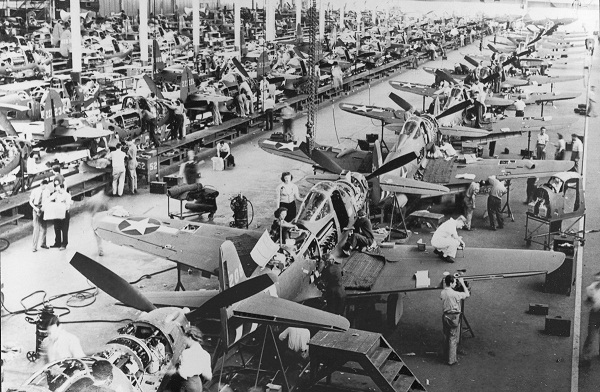 |
|---|
|
The Bell P-39 Airacobra production line at Wheatfield, near Niagara Falls, New York. Many women worked in the plant building P-39s and P-63s during the war.
|
|
In comparison to the best fighters of the day such as the P-51, P-38,
P-47, Bf 109, Spitfire and Zero, it got a bad rap because of its poor showing in the early European theater. This arena was for the most part high-altitude aerial battles and without the turbo-supercharger, the P-39 just could not compete. However, in other theaters of war, flying low-level operations, such as the Eastern Front in Russia, in the Pacific and North Africa, it performed rather well.
Even though it was extremely difficult to service because of the engine placement, the Russians still loved their P-39s. On the Eastern Front, parts were in short supply since they had to come all the way from Buffalo in New York, but the Russians were able to scavenge parts from P-39s damaged in accidents or crashes to keep their available P-39s in the air. And the P-39's short range wasn't an issue since it was mostly used for homeland defense. The Americans demanded the best fighter planes and they got them, but the Russians used what was available and made the most out of what they had. It was mostly a matter of training for the Russians and Günter Rall, with 275 victories and the third best Luftwaffe experten, commented that by 1942, the Russians were becoming much better pilots, "In capable hands the P-39 was a challenge to the Bf 109 F & G models."14 A total of 9,558 P-39s were produced with the major variants being the P-39D, P-39N and P-39Q of which almost half were sent to Russia under the Lend-Lease program.13 While the Airacobra was never one of the best airplanes, it was still a good airplane. The P-39 introduced many new innovations that would later be used on America's first jet powered airplane, the XP-59 Airacomet.15 |
| Major P-39 Variants | |||
|---|---|---|---|
| | |||
| • | XP-39 | Model 11 | Prototype with one turbo-supercharged 1,150 hp Allison V-1710-17 engine. No armament. |
| | |||
| • | XP-39B | - | Prototype with one 1,090 hp Allison V-1710-37 engine. No armament. |
| | |||
| • | P-39C | Model 13 | Production model with one 1,150 hp Allison V-1710-35 engine, with one 37 mm cannon firing through the propeller hub, and two .030 Mg and two 0.50 Mg mounted in the nose. |
| | |||
| • | P-400 | Model 14 | Production model with one 1,150 hp Allison V-1710-35E-A engine, with one 20 mm cannon firing through the propeller hub, two 0.50 Mg mounted in the nose, four wing mounted .030 Mg, and one 500 lb bomb. |
| | |||
| • | P-39D | Model 15 | Production model with one 1,150 hp Allison V-1710-35 engine, with one 37 mm cannon firing through the propeller hub, two 0.50 Mg mounted in the nose, four wing mounted .030 Mg, and one 500 lb bomb. Introduced self-sealing fuel tanks. |
| | |||
| • | P-39D-1 | Model 15 | Production model with one 1,325 hp Allison V-1710-63 engine, with one 37 mm cannon firing through the propeller. Mg same as P-39D. |
| | |||
| • | P-39D-2 | Model 15 | Production model 20 mm cannon replaced the 37 mm cannon firing through the propeller. Mg same as P-39D. |
| | |||
| • | P-39K | - | Production model with one 1,325 hp Allison V-1710-63 engine. Armed as P-39D. Aero prop. |
| | |||
| • | P-39N | Model 26 | Production model with one 1,200 hp Allison V-1710-85 engine. Armed as P-39D. Aero prop. |
| | |||
| • | P-39Q | - | Production model with one 1,200 hp Allison V-1710-85 engine. One 37 mm cannon firing through the propeller hub with four 0.50 Mg. Two mounted in the nose and two in wings. |
| | |||
| Specifications: | ||||
|---|---|---|---|---|
| Bell P-39 Airacobra | ||||
| Dimensions: | ||||
| XP-39 | P-39D | P-39N | P-39Q | |
| Wing span: | 35 ft 10 in (10.92 m) | 34 ft 0 in (10.36 m) | 34 ft 0 in (10.36 m) | 34 ft 0 in (10.36 m) |
| Length: | 28 ft 8 in (8.74 m) | 30 ft 2 in (9.19 m) | 30 ft 2 in (9.19 m) | 30 ft 2 in (9.19 m) |
| Height: | 11 ft 0 in (3.35 m) | 11 ft 10 in (3.61 m) | 12 ft 5 in (3.78 m) | 12 ft 5 in (3.78 m) |
| Weights: | ||||
| Empty: | 3,995 lb (1,812 kg) | 5,462 lb (2,478 kg) | 5,657 lb (2,566 kg) | 5,645 lb (2,561 kg) |
| Gross Weight: | 5,550 lb (2,517 kg) | 7,500 lb (3,402 kg) | 7,600 lb (3,447 kg) | 7,700 lb (3,493 kg) |
| Performance: | ||||
| Maximum Speed: |
390 mph (628 km/h) @ 20,000 ft (6,096 m) |
368 mph (592 km/h) @ 12,000 ft (3,658 m) |
399 mph (642 km/h) @ 9,700 ft (2,957 m) |
385 mph (620 km/h) @ 15,000 ft (4,572 m) |
| Service Ceiling: | 32,000 ft (9,574 m) | 32,100 ft (9,784 m) | 38,500 ft (11,735 m) | 35,000 ft (10,668 m) |
| Normal Range: | 390 miles (628 km) | 800 miles (1,287 km) | 750 miles (1,207 km) | 650 miles (1,046 km) |
| Powerplant: | ||||
|
Allison V1710-17 1,150 hp turbo-supercharged 12-cylinder, Inline Vee, liquid cooled engine. |
Allison V1710-35 , 1,150 hp 12-cylinder Inline Vee, liquid cooled engine. |
Allison V1710-85 , 1,200 hp 12-cylinder Inline Vee, liquid cooled engine. |
Allison V1710-82 , 1,200 hp 12-cylinder Inline Vee, liquid cooled engine. |
|
| Armament: | ||||
| Not installed. |
One 37 mm cannon. Two 0.50 caliber mg. Four .30 caliber mg. Bomb load 500 lbs. |
One 37 mm cannon. Two 0.50 caliber mg. Four .30 caliber mg. Bomb load 500 lbs. |
One 37 mm cannon. Four 0.50 caliber mg. Two in nose, two in wings. Bomb load 500 lbs. | |
Endnotes:
|
1. David Mondey. The Concise Guide to American Aircraft of World War II. New York: Smithmark Publishers, 1982. 12. 2. Alain J. Pelletier. Bell Aircraft Since 1935. Annapolis, Maryland: Naval Institute Press, 1992. 28. 3. Glenn D. Angle, ed. Aerosphere 1941. New York: Aircraft Publications, 1941. A-16. 4. Lloyd S. Jones. U.S. Fighters, Army - Air Force 1920s to 1980s. Fallbrook, California: Aero Publishers Inc., 1975. 95. 5. Ivan Hickman. Operation Pinball, The USAAF’s Secret Aerial Gunnery Program in WW II. Osceola, Wisconsin: Motorbooks International, 1990. 67. 6. Howard Mingos, ed. The Aircraft Year Book for 1940. New York: Aeronautical Chamber of Commerce of America, Inc., 1940. 262. 7. Enzo Angelucci and Peter Bowers.The American Fighter. Sparkford, England: Haynes Publishing Group, 1987. 43. 8. Dmitriy Loza. Attack of the Airacobras, Soviet Aces, American P-39s, and the War Against Germany. Lawrence, Kansas: University Press of Kansas, 2002. 75. 9. Ibid. 22-24. 10. Vaclav Nemecek. Soviet Aircraft from 1918. Great Britain: Key Publishing Ltd., Nemecek & Schoenmaker, 1986. 58. 11. David Mondey. 17. 12. Enzo Angelucci. Airplanes from the Dawn of Flight to the Present Day. New York: McGraw-Hill Company, 1971. 12. 13. Dmitriy Loza. 9. 14. Laeston Faneuf. Lawrence D. Bell, A Man and His Company New York: The Newcomen Society in North America, 1958. 14. Leston Faneuf, Larry Bell’s successor, claimed in a 1958 speech to the Newcomen Society that 13,000 P-39s were delivered to the USAAF. One can only wonder why he made such an exaggerated claim. The only explanation could be that he meant the total of P-39s and P-63s combined, but even this total was less than 13,000 and almost half of both types combined were delivered to the Russians. It's no wonder that Leston Faneuf was regarded by many as “suspect competence.” Donald M. Pattillo. Pushing the Envelope, The American Aircraft Industry. The University of Michigan Press, 2003. 222. 15. Michael Pavelec. The Jet Race and the Second World War. London: Praeger Security International, 2007. 77. |
Larry Dwyer. © The Aviation History Online Museum. All rights reserved.
Created November 27, 2001. Updated May 26, 2015.